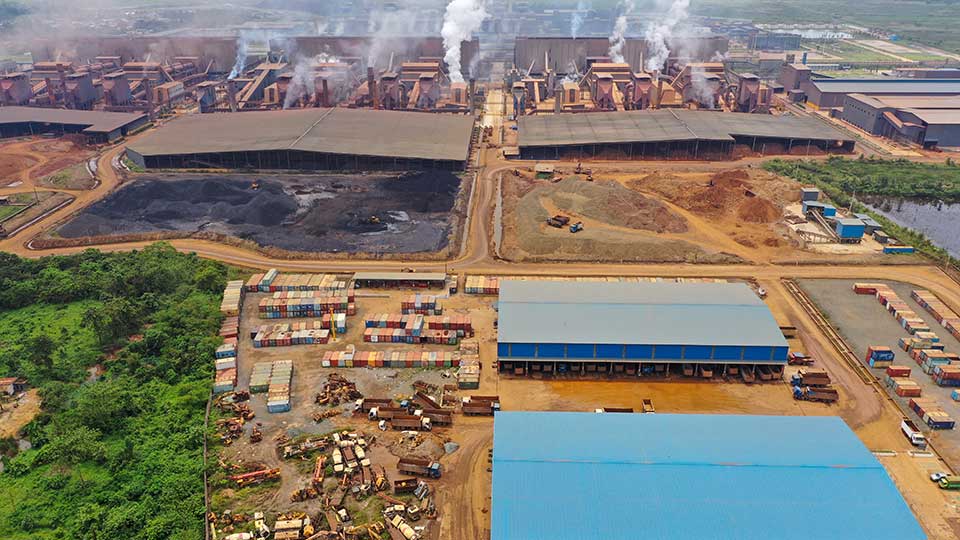
China’s Tsingshan Holding Group, which produces nearly one-third of the world’s stainless steel, has suspended major production lines at its Indonesian nickel smelter, the clearest sign yet that the global nickel market is buckling under glut, collapsing prices, and demand, fueling urgent calls for a moratorium on new nickel smelters in Indonesia.
The disruption in the form of nickel glut threatens Indonesia’s cornerstone industrial policy, which now faces rising calls for a moratorium as battery technologies pivot away from nickel.
Why it Matters
The suspension exposes deep vulnerabilities in Indonesia’s export-heavy nickel strategy.
It signals global market instability and raises questions over the sustainability of Indonesia’s downstreaming ambitions in the face of collapsing prices and shifting EV battery technology.
Tsingshan halted several stainless steel lines at its facility in the Indonesia Morowali Industrial Park (IMIP), Central Sulawesi, beginning in May 2025.
The facilities have been placed into open-ended maintenance with no timeline for resumption.
“As I said, [smelter] margins have continued to fall in recent months, since late last year. Many smelters and players out there are struggling with this issue.”
Steven Chen, Global Sales Head, Eternal Tsingshan Group Ltd
Chen confirmed the company is diverting stainless steel exports away from China to other markets, citing price collapses in both China and Indonesia.
The Big Picture: Global Glut Triggers Smelter Moratorium Calls
- Global spot prices for nickel ore dropped –13.2% year-on-year, a signal of sustained oversupply.
- Prices for stainless steel in both China and Indonesia hit five-year lows in April 2025.
- Indonesia currently operates 44 nickel smelters, a number economists call excessive.
“China’s demand for processed nickel is weakening. The sharp –13.2% year-on-year drop in international spot nickel ore prices is a clear signal that oversupply is still persistent,” said Bhima Yudhistira, Executive Director, Center of Economic and Law Studies (Celios).
He added that Indonesia’s current production capacity is misaligned with demand: “That number is far too high; there’s now a clear mismatch between supply and demand,” said Yudhistira.
“So now we have to ask, why are nickel mining licenses still being handed out? What’s the point of allowing more smelters? This downstreaming drive is getting more irrational by the day. We’ve consistently pushed for a moratorium on new smelter and mining licenses, it’s the only way to protect Indonesia’s nickel prices.”
BHIMA YUDHISTIRA, Executive Director, Celios
Expert Warnings: Too Many Smelters, Too Few Buyers
Yudhistira also flagged overdependence on China as a structural risk.
“As long as the market remains heavily dependent on China and no alternative export markets have emerged, this under-absorption of nickel is a yellow light warning,” said Yudhistira
He criticized Indonesia’s downstream strategy for misallocating its nickel reserves.
“The government has been overly arrogant about Indonesia’s vast nickel reserves. But those reserves aren’t being used for EV battery materials, they’re being funneled into stainless steel production instead,” said Yudhistira
He further blamed early-stage planning and incentives.
“This was poor planning from the start. The companies given tax holidays and tax allowances haven’t meaningfully contributed to the battery ecosystem,” said Yudhistira
EV Battery Shifts Threats, Smelter Moratorium Urged
Yudhistira pointed to emerging technologies as a long-term threat to nickel relevance.
“Nickel used to be essential for batteries. Now we have lithium iron phosphate (LFP) batteries, and China’s already moving into sodium-based alternatives, and that’s a serious threat to the long-term viability of our downstreaming strategy,” said Yudhistira
This outlook prompted his call for policy restraint.
Zoom Out
The Indonesian Nickel Miners Association (APNI) confirmed that production slowdowns are not isolated to Tsingshan smelter.
“This isn’t just happening at Tsingshan or IMIP, it’s spreading to other smelters too, like in Weda Bay, North Halmahera,” said Djoko Widajatno, APNI Advisory Board, last week.
He cited multiple causes: oversupply, nickel ore shortages, ESG pressures, and falling demand.
“We are asking the government to intervene with policy adjustments, such as revising RKAB [Work Plan and Budget] quotas and rescheduling smelter expansions. Or limited export regulation, this will likely be needed to stabilize the industry,”
Djoko Widajatno, APNI Advisory Board
Meidy Katrin Lengkey of APNI echoed the concern, citing rising input costs.
“It’s not a full production shutdown, just several production lines. The main issue is that costs have shot up. Ever since the royalty hike, ore prices have doubled,” said Meidy Katrin Lengkey, Secretary General, APNI, last week.
She added that smelters across the sector are scaling back.
“You can’t blame it solely on higher royalties; overall production costs have climbed, and the selling price just isn’t worth it anymore. This includes Virtue Dragon Nickel Industry and also Huadi; they’ve reduced production too. So NPI output capacity may decline this year,” said Lengkey.

Indonesian Government: All is Still Okay
Despite these warnings, Indonesia’s government remains publicly optimistic.
“Even before the shutdown, nickel prices were already quite good. In fact, the ore market is pretty decent, so there’s no impact at all,” said Tri Winarno, Director General of Mineral and Coal, Ministry of Energy and Mineral Resources (ESDM), at the Human Capital Summit last week.
- Tsingshan produced nearly one-third of global stainless steel in 2024, per Macquarie Group Ltd.
- China and Indonesia together account for 71% of global stainless steel output.
- Indonesia supplies over 50% of global base metal needs, including nickel.
Export prospects for Indonesian nickel are further complicated by ongoing tariff tensions under U.S. President Donald Trump’s administration. Both countries are entering the second phase of tariff negotiations this week.
